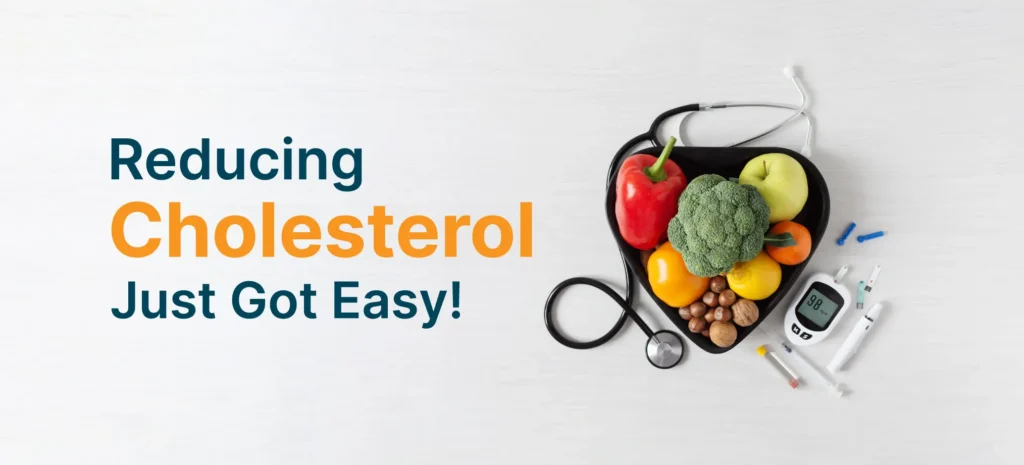Foods and Habits That Help Slash Your Cholesterol Levels
Cholesterol is a naturally occurring substance in the body, essential for many functions, including building cell membranes and producing hormones. However, an imbalance especially high levels of low-density lipoprotein (LDL), often called “bad cholesterol” can increase the risk of heart disease, strokes, and other cardiovascular conditions. Fortunately, a combination of diet and healthy habits can help manage cholesterol levels effectively.
This article explores specific foods and lifestyle changes that have been scientifically proven to help reduce cholesterol, focusing on practical, easy-to-adopt strategies for maintaining a healthy heart and overall well-being.
Understanding Cholesterol: The Good and the Bad
Cholesterol is transported through the bloodstream in two major forms:
Low-Density Lipoprotein (LDL): Often referred to as “bad cholesterol,” this form contributes to the accumulation of fatty deposits on artery walls, narrowing them and increasing the risk of heart disease.
High-Density Lipoprotein (HDL): Known as “good cholesterol,” HDL helps remove LDL cholesterol from the bloodstream, transporting it to the liver for excretion.
To maintain cardiovascular health, it’s crucial to reduce LDL levels while increasing HDL levels.
Foods That Help Lower Cholesterol
Certain foods play an essential role in reducing LDL cholesterol and boosting HDL. Below are some of the most effective foods that can support healthy cholesterol levels.
Oats and Whole Grains
How They Help: Oats, barley, and other whole grains contain beta-glucan, a type of soluble fiber that binds to cholesterol in the digestive system and helps eliminate it before it enters the bloodstream.
How to Add Them to Your Diet:
Begin your day with a bowl of oatmeal topped with fruits like berries or bananas.
Opt for whole grains like quinoa or barley instead of refined grains.
Snack on whole-grain crackers or fiber-rich granola bars for a cholesterol-friendly option.
Nuts and Seeds
How They Help: Nuts such as almonds, walnuts, and seeds like chia and flaxseeds are rich in healthy fats, fiber, and plant sterols that help lower LDL cholesterol.
How to Add Them to Your Diet
Enjoy a handful of raw or lightly roasted nuts as a snack between meals.
Sprinkle flaxseeds on your morning smoothie or yogurt for a fiber boost.
Add nuts to your salads or use them to make nut butters for spreads.
Fatty Fish
How They Help: Fatty fish like salmon, mackerel, and sardines are packed with omega-3 fatty acids, which can lower triglyceride levels and raise HDL cholesterol.
How to Add Them to Your Diet:
Include fatty fish in your meals twice a week, either grilled, baked, or roasted.
Make a quick tuna or salmon salad for lunch or a healthy fish curry for dinner.
Use canned salmon or sardines as convenient, heart-healthy options.
Legumes and Beans
How They Help: Beans, lentils, and other legumes are excellent sources of soluble fiber and plant-based protein, both of which help reduce LDL cholesterol.
How to Add Them to Your Diet
Prepare hearty lentil soups or bean-based stews for lunch or dinner.
Use beans to make veggie burgers or replace meat in tacos or chili.
Snack on roasted chickpeas or add beans to salads for a protein-packed meal.
Fruits and Vegetables
How They Help: Many fruits and vegetables, such as apples, citrus fruits, spinach, and broccoli, are rich in antioxidants, soluble fiber, and plant compounds that help reduce cholesterol levels.
How to Add Them to Your Diet:
Aim to fill half of your plate with colorful fruits and vegetables at every meal.
Prepare vegetable-based soups or smoothies for easy and nutritious snacks.
Keep fresh fruits on hand for a quick and healthy snack.
Avocados
How They Help: Avocados are an excellent source of monounsaturated fats and plant sterols, both of which are effective in reducing LDL cholesterol levels without impacting HDL levels.
How to Add Them to Your Diet:
Use mashed avocado as a spread for toast or sandwiches.
Add avocado to salads for a creamy, nutrient-rich addition.
Blend avocado into smoothies for a smooth, creamy texture and healthy fats.
Olive Oil
How It Helps: Extra virgin olive oil contains monounsaturated fats that help reduce LDL cholesterol while maintaining healthy HDL levels.
How to Add It to Your Diet:
Drizzle olive oil over salads as a base for homemade salad dressings.
Use olive oil in place of butter or margarine when sautéing vegetables.
Incorporate olive oil into your cooking by using it as a substitute for less healthy oils.
Green Tea
How It Helps: The antioxidants in green tea, particularly catechins, help lower LDL cholesterol and improve overall heart health.
How to Add It to Your Diet:
Drink 2-3 cups of green tea daily to support cholesterol reduction.
Enjoy green tea as a refreshing iced beverage or add lemon for an extra boost of antioxidants.
Swap sugary drinks for green tea to reduce your calorie intake and improve heart health.
Dark Chocolate
How It Helps: Dark chocolate, especially with high cocoa content (70% or more), contains flavonoids that can help lower LDL cholesterol while raising HDL levels.
How to Add It to Your Diet:
Enjoy a small piece of dark chocolate as a treat after meals.
Use dark chocolate in smoothies or desserts to add richness and health benefits.
Make homemade dark chocolate bark with nuts and dried fruits for a healthy snack.
Soy Products
How They Help: Soy-based foods like tofu, soy milk, and edamame contain plant protein that can help lower LDL cholesterol when consumed regularly.
How to Add Them to Your Diet:
Swap out meat for tofu or tempeh in stir-fries or salads.
Use soy milk as a substitute for dairy milk in smoothies or cereals.
Snack on steamed edamame for a protein-rich, heart-healthy option.
Healthy Habits That Support Cholesterol Management
Adopting heart-healthy habits is just as crucial as incorporating cholesterol-lowering foods into your diet. Here are several practices that can help support healthy cholesterol levels:
Exercise Regularly
How It Helps: Physical activity helps increase HDL cholesterol and decrease LDL and triglycerides.
Action Plan:
Engage in moderate aerobic exercises like brisk walking, cycling, or swimming for at least 30 minutes on most days.
Incorporate strength training exercises two to three times a week to improve overall cardiovascular health.
Make exercise enjoyable by taking up activities like dancing or playing a sport you love.
Quit Smoking
How It Helps: Smoking lowers HDL cholesterol levels and harms blood vessels, contributing to the risk of heart disease. Quitting smoking can significantly improve cholesterol levels.
Action Plan:
Seek support from a healthcare provider or support groups to quit smoking.
Replace smoking with healthier habits like taking walks or chewing gum.
Celebrate milestones such as one week, one month, and one year smoke-free to stay motivated.
Limit Alcohol Consumption
How It Helps: Excessive alcohol consumption can raise triglyceride levels and contribute to weight gain, which negatively impacts cholesterol levels.
Action Plan:
Stick to the recommended guidelines: one drink per day for women and up to two drinks for men.
Opt for healthier drink alternatives such as sparkling water or herbal teas.
Limit alcohol intake during social events and choose moderation as your goal.
Manage Stress
How It Helps: Chronic stress can elevate LDL cholesterol and contribute to unhealthy lifestyle choices.
Action Plan:
Practice relaxation techniques like deep breathing, yoga, or meditation to manage stress.
Engage in hobbies or activities that relax your mind, such as painting, gardening, or listening to music.
Seek professional counseling or therapy if you’re feeling overwhelmed by stress.
Maintain a Healthy Weight
How It Helps: Being overweight or obese can increase LDL cholesterol and lower HDL cholesterol. Even modest weight loss can significantly improve cholesterol levels.
Action Plan:
Aim to lose 5-10% of your body weight by combining a healthy diet and regular exercise.
Focus on nutrient-dense, whole foods to nourish your body and avoid processed foods.
Make physical activity a part of your daily routine, from walking or biking to taking the stairs instead of elevators.
Conclusion

Reducing cholesterol levels doesn’t require drastic changes but rather consistent, mindful efforts. By adopting a diet rich in cholesterol-lowering foods such as oats, fatty fish, and avocados, and incorporating positive lifestyle habits like regular exercise, stress management, and smoking cessation, you can naturally and effectively improve your cholesterol profile. Taking small steps today will set you on a path to better heart health and a higher quality of life. Start today your heart will thank you.





